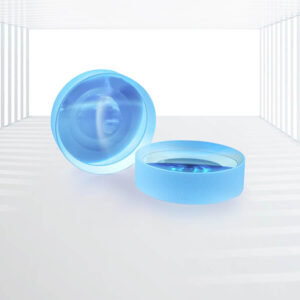Brewster Angle Prisms
Minimal Deviation: The apex angle of the Brewster Prism is specifically crafted such that p-polarized light incident at the Brewster’s angle passes through the prism in a direction parallel to its base, experiencing minimal deviation.
Efficient Polarization Manipulation: By exploiting the Brewster angle, these prisms are optimized for efficient polarization manipulation, making them ideal for applications where surface reflection losses cannot be tolerated.
Wavelength Selection: Brewster Prisms also possess the capability to select a single wavelength from a multi-wavelength laser, enhancing their versatility in various optical systems.
Tuning Flexibility: The prisms can be tilted to achieve the desired tuning, providing additional control over the polarization and wavelength selection process.
Applications: Polarimetric Instruments, Lasers, Polarization Mode Locking, Polarization-Based Spectroscopic Measurements, etc.
The Brewster Prism is a precision optical component designed to harness the unique properties of the Brewster angle. This critical concept in optics dictates the behavior of light at the interface between two media with differing refractive indices. When light encounters a transparent medium at the Brewster angle, a remarkable phenomenon occurs: the reflected rays and refracted light components become perpendicular to each other, resulting in the reflected light being entirely polarized parallel to the interface.
Specifications:
| Material | N-BK7, Fused Silica, MgF2, N-SF10… |
| Surface Quality | 40/20 S/D |
| Dimension Tolerance | +0.0/-0.2mm |
| Flatness | <λ/4@632.8nm |
| Clear Aperture | >90% |
| Polished Surface | Two side surfaces polished, base is fine ground |
| Angle Tolerance | <5 arc minutes |
| Coating | uncoated, or custom |
| Chamfer | Protective<0.5mmx45° |
| Range of Size | / |
Features:
- Minimal Deviation: The apex angle of the Brewster Prism is specifically crafted such that p-polarized light incident at the Brewster’s angle passes through the prism in a direction parallel to its base, experiencing minimal deviation.
- Efficient Polarization Manipulation: By exploiting the Brewster angle, these prisms are optimized for efficient polarization manipulation, making them ideal for applications where surface reflection losses cannot be tolerated.
- Wavelength Selection: Brewster Prisms also possess the capability to select a single wavelength from a multi-wavelength laser, enhancing their versatility in various optical systems.
- Tuning Flexibility: The prisms can be tilted to achieve the desired tuning, providing additional control over the polarization and wavelength selection process.
Applications:
- Polarimetric Instruments: Brewster Angle Prisms are essential components in polarimetric instruments, which measure the polarization state of light. These prisms enable precise polarization manipulation, allowing for accurate measurements and analysis.
- Lasers: In laser systems, Brewster Angle Prisms are used to select a specific wavelength from a multi-wavelength laser beam. This capability makes them valuable in applications where precise wavelength control is crucial.
- Polarization Mode Locking: Brewster Angle Prisms play a role in polarization mode locking, a technique used to stabilize the polarization state of light in optical systems. By manipulating polarization, these prisms help maintain a consistent and reliable polarization mode.
- Polarization-Based Spectroscopic Measurements: Spectroscopic measurements that rely on polarization analysis benefit from the use of Brewster Angle Prisms. These prisms allow for precise polarization manipulation, enabling accurate and sensitive spectroscopic measurements.
Kingwin Optics offers Custom Brewster Angle Prisms manufactured from a range of substrate materials, including BK7, Fused Silica, MgF2, CaF2, N-SF10, and more. With precise geometric control, we ensure the full effect of the Brewster angle is utilized, resulting in optimal polarization manipulation and minimized optical losses.











